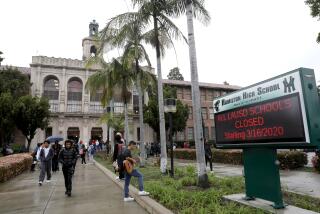L.A. Unified’s iPad plan doesn’t compute
It has been a year since Los Angeles Unified schools Supt. John Deasy proposed putting a tablet computer in the hands of every student in the district. At that time, there were numerous questions about how and whether this would work. Could first-graders really take care of such expensive equipment? Who would be held responsible if one of the devices was stolen, lost or broken, or if apple juice was dripped into the circuitry? How would the district keep high-schoolers off porn sites? And how much would all this cost?
Deasy said these details would be worked out before any decisions were made. But all we know for sure a year later is the price tag: a whopping $1 billion to provide more than 600,000 students and their teachers with top-of-the-line, software-equipped iPads at $678 each, plus the necessary Wi-Fi in the schools. The district has forged ahead — 47,000 students have received iPads already, with a much bigger purchase planned soon — yet vital issues remain inadequately addressed.
Still unclear, for example, is who pays for accidental loss or damage to the iPads. Under the district’s contract, Apple will replace up to 5% of the devices for free. After that, the district is on its own. Parents at different schools have been given different information about whether they would have to cover the cost, and Deasy said he’s still trying to figure this out. Isn’t this something he should have done before any iPads were purchased?
The district also is coming to terms with how quickly its students disabled the firewall on their tablets to gain broad access to the Internet when they’re not on campus. There are potential liability and safety issues at stake — if, for example, a student were to make contact with a sexual predator on a school-issued iPad. While it tries to figure that out, the district has decreed that students may not take the tablets home, which seriously limits their usefulness as tools for integrating their class studies and homework. L.A. Unified has taken pains to discourage theft by enabling its iPads to be located and shut off if they are stolen. But are thieves really going to consider in advance whether the device they are looking to grab will work after it’s stolen? More likely, once the tablet went dead, they would throw it in the trash.
There’s also the matter of keyboards. Apparently the district hadn’t foreseen that it might need to purchase them as well, at a so-far unknown cost.
Access to iPads and other high-tech devices could be of tremendous benefit to L.A. Unified students, many of whom have few digital resources at home. But at this point, the district should be well beyond the “we’re figuring this out” phase. It has spent some $30 million already, and in November, Deasy is scheduled to ask for close to $200 million more to provide iPads for an additional 300,000 students by the end of the school year. Given the many easily foreseen questions that have not been resolved, the board should require a more gradual rollout so that problems can be identified and addressed before it is too late to change course.
More to Read
A cure for the common opinion
Get thought-provoking perspectives with our weekly newsletter.
You may occasionally receive promotional content from the Los Angeles Times.










